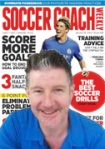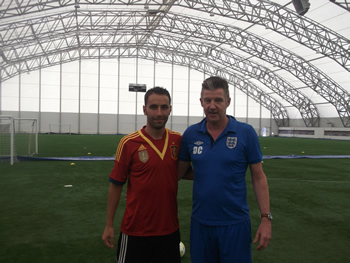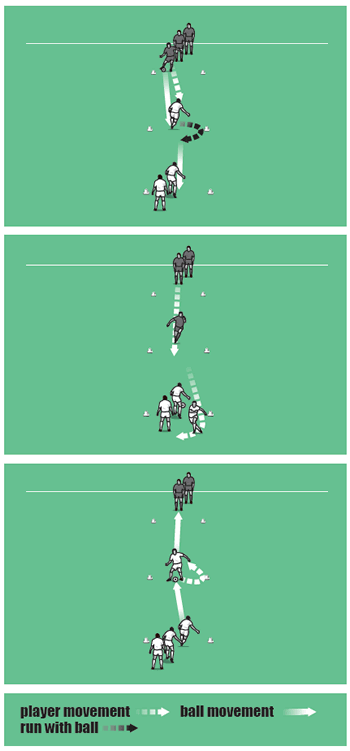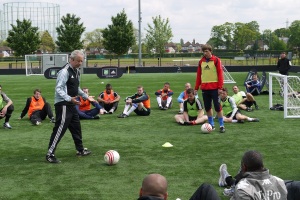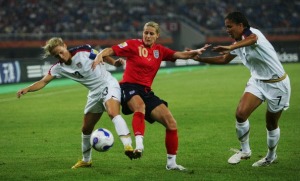Filed under: Dave Clarke, Soccer Coaching, Soccer Fitness, Soccer News, Soccer Refereeing, Soccer Skills, Soccer Team Management, Soccer Training | Tags: alf, Ardiles, coerver, development, Football, galustian, japan, maradona, messi, ossie, Soccer, World Cup, youth
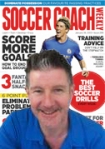 As a young player Ossie Ardiles was smaller than the other boys around him so he wouldn’t pass the ball much – he would just dribble and dribble and dribble. Much like Maradona and Lionel Messi. His brother called him Piton, the snake. In this exclusive interview Soccer Coach Weekly’s David Clarke spoke to him about youth soccer, Argentina legends and Japanese success
As a young player Ossie Ardiles was smaller than the other boys around him so he wouldn’t pass the ball much – he would just dribble and dribble and dribble. Much like Maradona and Lionel Messi. His brother called him Piton, the snake. In this exclusive interview Soccer Coach Weekly’s David Clarke spoke to him about youth soccer, Argentina legends and Japanese success

Most recently Ossie Ardiles was the coach of Machida Zelvia in the second tier of the Japanese J-League, but a 23-year coaching career has taken the Argentinian World Cup winner around the world. As player-manager he introduced a flamboyant style of football to Swindon Town in his first coaching job, achieving promotion to the top flight in 1990 (only for the FA to strip the club of this honour for off-the-field irregularities).
Three years later he took West Brom to Division One and later made headlines in the Premier League with a cavalier Spurs side notable for fielding five forwards. After relocating to Japan he was named J-League Manager Of The Year in 1998 for his work with Shimizu S-Pulse. He won the first stage of the J-League with Yokohama F Marinos in 2000 and the Emperor’s Cup with Tokyo Verdy five years later.
He has also enjoyed spells managing clubs in Mexico, Argentina, Paraguay, Croatia, Israel and Saudi Arabia, giving him a truly global view of the game – but wherever he has coached, he has always brought a certain Ossie style to the job.
DAVID Having coached four clubs in England, is the Premier League the best in the world?
OSSIE“The Premier League is certainly the most watched and the richest – and it attracts the best players in the world because of these reasons. Yes, I would imagine it’s the best league in the world.”
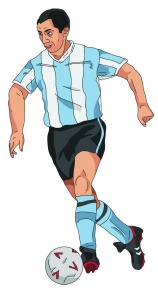 You have enjoyed several stints in Japan. What is it about the Japanese game that attracts you?
You have enjoyed several stints in Japan. What is it about the Japanese game that attracts you?
“The J-League started in 1993 and I came soon after. I think the J-League is and was the model of how professional football should be marketed for the fans. In Japan I have won the League and The Emperors Cup and I have been told that I also have more victories than any other foreign coach in the league’s history.”
Who have been the coaches that have impressed you the most in Japan?
“There have been some great coaches in Japan: the Brazilian legend Zico, Hans Ooft from Holland, and of course Arsene Wenger. Wenger to me was special – you knew his teams would play football, the beautiful game as Pelé called it. I know his time in Japan influenced him and like me he loved the culture. Since leaving Japan I am not surprised to see he stuck with all his beliefs about the way the game should be played and the way to behave civilly and with respect – the Japanese way.”
Japanese women are world champs and the men are champions of Asia. Why has their game been so successful?
“You need to understand the Japanese culture. Like every aspect of their lives, great attention and care is spent on detail, studying whatever they want to establish and then replicating and improving it. Football was no different. The professional league was marketed to perfection, so the fans supported the game. The Japanese also think long term so youth development was always a priority for the Japanese Football Association. The success of Japanese players and teams today is a result of their youth development programmes.”
As a long-standing champion of youth development and the education of coaches, what programmes have impressed you in Japan?
“In my 17 years here, the programme that has impressed me most, and the one that has dominated nationally, has been the Coerver programme. I remember in the early years they started with a few schools and today they have over 100 schools all over the country. I am a close friend with Alf Galustian, who is a co-founder of the programme and the driving force behind it, so I have always kept a close interest.”
 What is so special about the contribution of Alf Galustian and Coerver to football in Japan?
What is so special about the contribution of Alf Galustian and Coerver to football in Japan?
“Alf is without doubt a global pioneer in youth coaching. I am still amazed with the new drills, games and concepts he continually comes up with. His contribution to Japanese football development is without question. “Over these past 20 years he has influenced the way football is taught in Japan and the subsequent success of the game here. “Currently more than 17,000 young players go through the Coerver programme each week, and in the past 20 years over 300 players have gone into J-League clubs and some to the various national teams – that’s an amazing contribution to the game in Japan.”
After winning the 1978 World Cup, was it difficult to adjust to playing your football in England?
“It took me a while. In those days the long ball game – getting the ball into opposition’s third, often bypassing midfield – was strange to me. But at Spurs we had Glenn Hoddle, and Ricky Villa came with me too, so Spurs always tried to play passing football and that suited me.”
Would you say there is an Ossie Ardiles way of playing soccer?
“Yes. I have always believed in the passing game. My style is about possession but also always trying for the forward pass. I have always believed in attacking, as a player and as a manager – I have often been sacked for these beliefs but I will never change. Football is a technical game and that’s where its beauty is.”
 Ossie’s Verdict Maradona or Messi?
Ossie’s Verdict Maradona or Messi?
“It’s very close and they’re both fellow Argentinians. I think it would be Messi, but I have to qualify that. Maradona was the best player I played with by a mile. I have never seen such a skilled player. He could control the ball on any surface, in any space, and whatever the pressure he was put under. But Messi is playing in an era when there is improved knowledge in sports science about what you eat, drink, and how you prepare. Today the boots and the ball are superior. Today the fields are all unbelievable. So when people speak about comparisons between players like Maradona and Messi, all these factors should be taken into consideration.”
Ossie’s Coaching Career
1989–91: Swindon Town (England)
1991–92: Newcastle United (England)
1992–93: West Brom (England)
1993–94: Tottenham Hotspur (England)
1995: Guadalajara (Mexico)
1996–98: Shimizu S-Pulse (Japan)
1999: Dinamo Zagreb (Croatia)
2000–01: Yokohama F Marinos (Japan)
2001: Al-Ittihad (Saudi Arabia)
2002–03: Racing Club (Argentina)
2003–05: Tokyo Verdy (Japan)
2006–07: Beitar Jerusalem (Israel)
2007: Huracán (Argentina)
2008: Cerro Porteño (Paraguay)
2012: Machida Zelvia (Japan)
Filed under: Dave Clarke, Soccer Coaching, Soccer Fitness, Soccer News, Soccer Refereeing, Soccer Skills, Soccer Team Management, Soccer Training | Tags: coerver, drills, futsal, sessions, skills, technique, turning
 Great way to coach turning with this simple session you can use to coach your players – it also makes a good warm up.
Great way to coach turning with this simple session you can use to coach your players – it also makes a good warm up.
How to play it
• Set up an area measuring 20×5 yards, as shown, with two cones marking the midway length point.
• The player in the middle receives a pass from the front player in the top line – this man then follows his pass.
• The middle player must make a turn, pass out, then follow his pass to join the group at the bottom.
• The player who originally passed from the top line now becomes the new middle player.
• For the next part, a pass is fed in from the bottom line.
• The process continues with the player in the middle receiving the pass, but his ‘turn and move’ must be different to the one used by the player before him.
• There are many ‘turn and move’ choices, including:
- An open body turn
- Opening legs and flicking the ball in between
- Open legs and dummying Making a Cruyff turn
• The practice continues until all players are suitably warmed up in passing, controlling, turning and moving on.
Technique and tactics
• Players must be on their toes at all times.
• You’re looking for imagination in terms of how they turn.
• The quality of passing to and from the middle man is essential if this warm-up is to maintain its momentum.
Filed under: Dave Clarke, Soccer Coaching, Soccer Fitness, Soccer News, Soccer Refereeing, Soccer Skills, Soccer Team Management, Soccer Training | Tags: Alf Galustian, coerver, drills, gerard houllier, jurgen klinsmann, ossie ardiles, skills, vicente del bosque
 Alf Galustian is a modern-day football coaching legend. He has worked with the likes of Jurgen Klinsmann, Vincente del Bosque, Gerard Houllier and Ossie Ardiles and is now the skills coach to the Premier League.
Alf Galustian is a modern-day football coaching legend. He has worked with the likes of Jurgen Klinsmann, Vincente del Bosque, Gerard Houllier and Ossie Ardiles and is now the skills coach to the Premier League.
When he co-founded the Coerver Coaching programme in 1984 alongside former Chelsea and Scotland star Charlie Cooke, the principle was quite simply in focusing on and developing an individual player’s core skills.
The success of the philosophy led to a clamour for his expertise, and to this day, he has worked at AC Milan, Bayern Munich, Stoke City, Newcastle United and Arsenal, amongst others.
 DC: A lot of coaches just starting out might not understand what core skills are. Can you define the term please?
DC: A lot of coaches just starting out might not understand what core skills are. Can you define the term please?
AG: For us in Coerver Coaching, we define core skills as:
• Running with the ball
• 1v1
• First touch
• Passing/shooting
The foundation for all these core skills is Coerver Ball Mastery.
DC: How should grassroots coaches begin their season – what should they be focusing on for the first three months of the campaign?
AG: Players return to pre-season having not played for months and we recommend that coaches focus most of the early sessions on drills, helping their lads regain a feel for ball.
And we would suggest that at least 20% of the session is devoted to repetition exercises with the ball. Repetition can be boring so disguise it by incorporating the principles into competition scenarios between players and/or groups. The rest of the session should be a mix of passing and receiving drills, and small-sided games.
DC: How should this move on as the season advances, to ensure grassroots players are developing?
AG: The goal of each session is fun and progress, not only as a team but as individuals. The Coerver method of improving players is what we call ‘step-by-step teaching’. We break down the core skills and then teach through repetition, before increasing difficulty. Finally, we look for the use of those skills in game situations.
DC: Most coaches at grassroots level will have players of wildly differing abilities – how would you cope with that?
AG: This is a really good question and one that we have been asked a lot over Coerver Coaching’s 30-year history. Firstly, all players should do the same drills. A good tip is to split the group into threes and fours, putting players of similar abilities together. The only difference is that for the more skilled players, you make the conditions different (e.g. altering the number of touches, the distance or the speed). The players feel equal since the drill is exactly the same. Once you get to the small-sided games, pool your squad, making sure that no one team has all the best players.
DC: Should coaches continually use one-touch exercises or is that not as relevant as two touches?
AG: One-touch is quite difficult for most grassroots players. We want our young players to experience success, which then builds up their confidence, interest and concentration. For those reasons we prefer two touch. Once the players improve then we suggest mixing one and two- touch drills.
DC: Most grassroots players might only train and play once a week. Is this enough?
AG: Simply, no. However, it’s a difficult situation to change. I don’t think we can expect to increase practice times significantly, so we need to be smarter in what and how we teach.
DC: You’re a skills specialist coach and I’ve seen your ability to demonstrate the skill you are coaching. How do grassroots coaches who are not as skilled as you demonstrate difficult techniques to youth players?
AG: The coach has two options. The first is to practise the skills every day, not as a player but as a teacher, slowly and deliberately. Charlie and I still do this after 30 years. The second option is to pick a player in your group to demonstrate. Just make sure any demonstration is done slowly.
DC: Why is it that players from Spain, Brazil and Argentina are so respected at the moment for the way they play the game?
AG: I think this explanation would need to be a whole new article! Generally the football culture of these countries has a long tradition of focusing and admiring skills above all else. That culture has pushed coaches and teachers towards allowing young players to express themselves without fear of failure. I suppose Coerver Coaching, in many countries, is a replacement of what players learnt in the old days through street soccer. Times have changed and in relatively affluent societies, street soccer has disappeared.
DC: How much influence do you think the English Premier League has had on grassroots players?
AG: The Premier League is the most exciting and certainly the most televised league in the world. In that regard, there is no doubt that grassroots players and coaches are influenced. I think the players and teams can be extremely positive influences when it comes to learning the game, fair play, and behavioural role models.
Filed under: Dave Clarke, Soccer Coaching, Soccer Fitness, Soccer News, Soccer Refereeing, Soccer Skills, Soccer Team Management, Soccer Training | Tags: Better football coaching, coach education, coaching, coerver, Courses, youth module
By David Clarke
What is fantastic about watching and listening to Alf Galustian about youth coaching is that it all makes perfect sense.
- Speed + technique + skill = player excellence
- Safety + competition + fun = coach excellence
For a coach working with youth players the sums add up. It’s all about touch, control, confidence, 1v1s, 2v1s, 4v4s, 1 goal, 2 goals, 6 goals, feinting, beating your partner, keeping the ball, winning the ball back – using the coaching environment to get the best out of your players in a safe, fun atmosphere.
I was watching Alf on his Coerver Coaching Youth Diploma which is aimed at coaches at all levels of the game – professional academy coach, grassroots coach, teacher or parent. It gives coaches a greater understanding of how to plan and execute more effective coaching sessions.
I’m on the course to learn and it doesn’t take long before I’m drawing diagrams and writing down the scenes that unfold before me on the Fulham Academy astro pitch, something which I can pass on to my readers of Soccer Coach Weekly.
 Alf is a co-founder of Coerver Coaching and the list of top clubs he has worked with around the world is as long as your arm. The course was held at Premier League team Fulham’s superb academy training ground and you really feel you are in a pure coaching environment.
Alf is a co-founder of Coerver Coaching and the list of top clubs he has worked with around the world is as long as your arm. The course was held at Premier League team Fulham’s superb academy training ground and you really feel you are in a pure coaching environment.
The Coerver Coaching concept concentrates on attacking, fast-flowing football and this style has been demonstrated during the past few years by teams such as Barcelona, Spain and those from South America.
In Alf’s own words: “The knowledge you gain on our diploma will help you to plan and deliver effective sessions that are challenging and fun for the young players that you work with and will hopefully provide the pathway to the devlopment of game effective, technical excellence which we are all striving towards.”
The final session of the day is about how to build and deliver a session. It was run by Coerver’s excellent coaching director Scott Wright who coached Fulham U12s for the session. Scott said: “Hopefully this session has helped or changed your outlook on how you will plan & deliver sessions.”
A great session to watch it gives loads of hints and tips about coaching groups of children and helping develop their playing ability.
There is no doubt that this course will make you a better coach so make a mental note to get yourself on the next one, Alf runs them up and down the country.
But if you can’t go on the course then why not invest in the Coerver CD set, there’s lots of material on how to help you plan your sessions.
To order the CD in Europe: Click Here
To order the CD in the USA: Click Here
There will be two further Diplomas in the summer, one at Manchester City on the 2nd and 3rd June & the second in Birmingham 9th and 10th June. For more information click here
Filed under: Dave Clarke, Soccer Coaching, Soccer Fitness, Soccer News, Soccer Refereeing, Soccer Skills, Soccer Team Management, Soccer Training | Tags: Alf Galustian, coerver, England, interview, Liverpool, Newcastle United, peter beardsley, skills, technique
 My series of interviews on influential figures in the world of coaching continues with this exclusive interview with Peter Beardsley.
My series of interviews on influential figures in the world of coaching continues with this exclusive interview with Peter Beardsley.
I remember Peter as a very skillful player, slight of build, operating just behind the front strikers at Newcastle, Liverpool and of course England.
His skills have proved devastating for creating and scoring goals, netting over 230 in his career. He was a player with lovely ball skills and fantastic vision, as well as tremendous stamina, enthusiasm and work-rate.
He was also able to score long range shots, or clever placement using timing and dribbling skills.
As a youth player Peter was discovered at the famous Wallsend Boys Club on Tyneside in the 70s – the club has a pedigree of bringing through great players including Alan Shearer, Michael Carrick, Lee Clark and Steve Bruce.
 He is now football development manager at Newcastle United helping to drive forward the recruitment of talented youngsters for the club’s Academy and Development Squad, so what better person to answer questions on how to coach youth skills.
He is now football development manager at Newcastle United helping to drive forward the recruitment of talented youngsters for the club’s Academy and Development Squad, so what better person to answer questions on how to coach youth skills.
I caught up with Peter at Newcastle where he was coaching with the world famous coach Alf Galustian and asked him about youth coaching and what a coach learns from watching someone as experienced as Alf.
1. We all have favourite areas of coaching – as a former attacker do you find it easy to coach defending as well as attacking exercises?
I think all coaches need to learn how to coach both topics: the modern player especially as a youth player has to be both attacker and when they lose the ball win it back by pressing deep – defending from the front. Messi is probably the best example.
2. As a skillful striker you must have had a few tricks you used, which were your favourite and how did you practice them.
I learnt mostly by playing – we didn’t have a programme like Alf’s Coerver Coaching, so most of what I did was learnt in games. If I had had a programme like Coerver to follow, I am sure it would have made me a better player, especially for scoring goals!
3. Messi and Ronaldo both use skill in their play but appear to have one or two clever moves that they use a lot. How many skills should a youth player work on to use in match play?
I think young players should learn as many skills can they can so they can use them to beat players in as many different ways as possible; it will help their future game and it’s great fun to learn new skills.
4. I think repetition is one of the most vital coaching tools. But players can find doing the same old thing boring. How do you hide repetition when coaching?
 As you know I have been close to Alf for many years – once I was exposed to Coerver (over 20 years ago) I realised that repetition was crucial for perfecting skills.
As you know I have been close to Alf for many years – once I was exposed to Coerver (over 20 years ago) I realised that repetition was crucial for perfecting skills.
I follow Alf’s view that for young players you can hide repetition by playing fun games – for example simple relays where repetition is included.
Watching Alf coach today I can see so many possibilities to coach young players in using skills to win 1v1s and 2v1s where the repetition is hidden by the actual game they play.
5. You played in youth teams at Wallsend Boys in the 70s, which one factor would you say is the most important change in the way kids are coached today?
The quality of facilities and the improvement in coaches knowledge and understanding of what is best for the players and not what is best for the coaches
6 Can you explain one specific exercise you have been using with your team that my coaches can go out and use with their players?
While Alf has been here at Newcastle we have been concentrating on attacking principles. This is one of the sessions I have seen Alf coach and I am now using to help my players in their attacking role.
SESSION: To improve Shooting under pressure
How to set it up
- 10 players plus a server or the coach
- A 40x25yd area with a goal and goalkeeper at each end.
- Two teams of four players and a server
- Each player has a ball lined up by each goal.
- Two cones 5 yards either side of the server
- The coach or a designated player is stationed in the middle of the field as a wall passer.
How to play it
- The first player in TEAM A passes to the server in the centre, then takes the return pass and after controlling and dribbling the ball shoots on the opposite goal.
- As he shoots the first player in TEAM B passes to the server and sprints to take a return pass and take at least one touch before shooting.
- As soon as the TEAM A player shoots he sprints around the cone to try to stop TEAM B from scoring.
- When TEAM B shoots he must recover around his marker cone to defend again the second player in TEAM A who’s repeats the sequence.
COACH’S TIPS
- At first the recovering player going around the marker cone will be too far and he will not be able to apply much pressure on the shooter.
- But gradually move the markers towards the Coach so the distances of recovery is less and less and there’s increasing pressure on the shooters.
- Eventually allow the recovering players to use the WP as their marker to go around.
PLAYER TIP
- Be sure the first pass to the server is firm so there’s no lag time waiting for the return pass and the defender to get close.
- Take your first touch from the server away from the approaching defender to set up your shot.
- Head up before shooting.
- Aim low far post the GKs toughest shot.
Filed under: Dave Clarke, Soccer Coaching, Soccer Fitness, Soccer News, Soccer Refereeing, Soccer Skills, Soccer Team Management, Soccer Training | Tags: ball mastery, ball skills, coerver, individual skills, youtube
Filed under: Dave Clarke, Soccer Coaching, Soccer Fitness, Soccer News, Soccer Refereeing, Soccer Skills, Soccer Team Management, Soccer Training | Tags: ball skills, coerver, hook turn, mastery, skills, step over
 What’s the point in coaching skills such as the ‘hook turn’? You know the one, where a player stops suddenly and hooks the ball behind the standing leg.
What’s the point in coaching skills such as the ‘hook turn’? You know the one, where a player stops suddenly and hooks the ball behind the standing leg.
“I hate watching step-overs so why should I coach my players to do them?” – this was the question one of my fellow coaches asked me last week when I explained that I was doing a ‘skills coaching’ series with my team.
The principle is that you show them a skill, make sure they can do it, then get them to perform it again at the start of the following week’s session. You tell them to practise at home and then see who has progressed most. It works well, and is a fun way to start sessions, ensuring that players are concentrating on the art of the game. But why coach them what some coaches see as tricks?
Well, speaking personally, I do it because I have a great belief that individual skills advance both my players and the team as a whole. The hook turn is simple to learn and my younger teams (Under-9s and Under-10s) love it. I get the boys to use the outside of the foot to turn 180 degrees. I like this turn because it coaches players to use a different part of their foot, and overall the move helps with their co-ordination.
It isn’t just about the actual skill itself. If players learn how to control the ball with different parts of their foot, it gives them the confidence to use those same areas to do things such as flicking the ball or performing half-turns away from defenders. Getting my players to continually vary the point of contact – whilst using both feet – is an ideal way to develop their ball skills. Individual moves like the hook turn are a great peg to hang these skills on, and I don’t get blinkered by the actual turn itself, because as long as they are using their foot and the ball differently, they are learning.
Which takes me back nicely to the step-over… it’s a much maligned move because of the amazing number of step-overs some players do. The simple move is a brilliant way for young players to dummy their opponent, faking to go one way before moving the other. It doesn’t look great to see young players doing three or four at the same time because that takes away from the simple skill itself.
I also believe the co-ordination involved helps players understand about body position and balance, so don’t be afraid to try something out of the ordinary, because sometimes it isn’t the direct benefit of the move that will prove the most profitable for your players.
Dribble and step over and shoot soccer coaching drill
Filed under: Dave Clarke, Soccer Coaching, Soccer Fitness, Soccer News, Soccer Refereeing, Soccer Skills, Soccer Team Management, Soccer Training, Uncategorized | Tags: 1v1, 2v2, Alf Galustian, Charlie Cooke, coerver, girls, skills, usa, women, women skills
 My series of interviews on influential figures in the world of coaching continues with this exclusive interview with Kristine Lilly. Kristine was a member of the United States women’s national soccer team for 24 years. She is the most capped men’s or women’s soccer player in the history of the sport, gaining her 352nd and final cap against Mexico in a World Cup qualifier in November 2010. Kristine played in five World Cup Finals, winning two World Cups to add to her numerous other awards and honours.
My series of interviews on influential figures in the world of coaching continues with this exclusive interview with Kristine Lilly. Kristine was a member of the United States women’s national soccer team for 24 years. She is the most capped men’s or women’s soccer player in the history of the sport, gaining her 352nd and final cap against Mexico in a World Cup qualifier in November 2010. Kristine played in five World Cup Finals, winning two World Cups to add to her numerous other awards and honours.
 She is now tasked with developing the next generation of female players and coaches in the USA. I caught up with her as she launched a skills partnership with Coerver coaching.
She is now tasked with developing the next generation of female players and coaches in the USA. I caught up with her as she launched a skills partnership with Coerver coaching.
1. Can you give me a brief outline of what you will be doing in your link up with Coerver Coaching?
I have joined a partnership with Coerver Coaching to continue to make a difference in the game. We hope to promote and improve the Women’s game globally. We have an inspiring curriculum that really works; improving the player on the field and the person off it.
2. Why Coerver?
 Well I have used the Coerver method throughout my career, and ever since I was a young girl. I believe in the Coerver system, the philosophy and the benefits it brings to players, coaches of any ability.
Well I have used the Coerver method throughout my career, and ever since I was a young girl. I believe in the Coerver system, the philosophy and the benefits it brings to players, coaches of any ability.
I am also hugely impressed at how the Coerver System and Brand has evolved and expanded globally, since Charlie Cooke and Alf Galustian (pictured) first started it almost 30 years ago.
Lastly Coerver works, players that go through this method improve, become better players and especially feel confident and comfortable on the ball.
3. The women’s game is huge in USA, what do you think players lack in terms of technique that your link up with Coerver can help players to step up a level?
I think US players are great athletes, wonderful competitors and have a winning mentality. However, I think we can be better with the ball; especially when and where we use it; make quicker decisions, but have the confidence if there are no passing options to keep the ball under pressure.
Also we can be more consistent, technique usually breaks down, as players get tired, so we need to continually work on improving our skills, which also has the added benefit of improving confidence. I am sure if you speak to top coaches and players they will put confidence (building) as a main priority. In a way Coerver does that by Mastery of Skills through repetition.
4. Having spent part of your career in Sweden do you think the women’s game in Europe can catch up with the USA? Are the skills/technique levels the same?
I think the level of play has advanced all over the world. I think the Europeans are improving quickly. I think they have become more technical than us in the past decade. I think the one thing that the USA has is a fighting mentality that edges out teams. However the technical side of the game has to be there to make that happen as well.
5. With regards to youth soccer in terms of both girls and boys I think repetition is one of the most vital coaching tools. But players can find doing the same old thing boring. How do you hide repetition when coaching?
 As a young player I spent many hours kicking a ball against a wall practicing my shooting technique and passing. Yes I would agree doing this alone could get boring, but once you see improvement in your game all the practice, hard work makes sense; boring or not.
As a young player I spent many hours kicking a ball against a wall practicing my shooting technique and passing. Yes I would agree doing this alone could get boring, but once you see improvement in your game all the practice, hard work makes sense; boring or not.
Also that is what is so great about the Coerver programme, you do basic drills that address the technical side of the game and then add pressure, and then make it a competitive atmosphere and it’s always challenging, progressively competitive and always fun!!!
6. You played in youth teams in the early 90s, which one factor would you say is the most important change in the way kids are coached today?
As in all countries there are excellent coaches who continually look for new, innovative ways of teaching and others who really don’t want to change from what they are used to. This is not a criticism, since in Grassroots Soccer all the coaches who give their time and effort mostly for free, need to be praised.
My main worry is that some Coaches are only interested in winning teams; winning is important, but in the formative ages Coerver and I believe the focus should be on development. If you are a young player, yes you want to win but at the same time you dream of improving to where one day you can a real difference!
 We don’t have, in my opinion enough players like this. Abby Wambach (USA Women), Marta (Brazil Women, pictured), Messi (Argentina), Xavi (Spain) of course, but Soccer needs more of these Special Players. That’s another thing I learned from Alf and Coerver about teaching based on models of Great Players. It’s a great way to teach and motivate.
We don’t have, in my opinion enough players like this. Abby Wambach (USA Women), Marta (Brazil Women, pictured), Messi (Argentina), Xavi (Spain) of course, but Soccer needs more of these Special Players. That’s another thing I learned from Alf and Coerver about teaching based on models of Great Players. It’s a great way to teach and motivate.
7. What are you coaching in your next session and how?
I like the Coerver theme sessions that Alf showed me at our last practice session together. Theme is Creating more Goal Chances individually; a session where you teach players how to can create goal chances (showing them different 1 v 1’s to create space either side of opponents to shoot, Improving Strikers first touch in the penalty box, so they have more time to shoot, Improving reaction speed for strikers.)
I pick games and drills that teach these topics.
How I would teach this or any other theme is by starting with a Coerver Ball Mastery exercise (as many touches of the ball both right and left foot. Lots of touches in 60 second bursts. I would then teach the 1 v 1 /First Touch technique in a group drill. No defenders, but just getting the technique correct, and finally I would finish with full pressure, defenders trying to win the ball
8. Can you explain one specific exercise you will coach that uses Coerver skills?
 There is one drill I like a lot right now. Here is the diagram and action. This drill not only improves attackers but also defenders, defenders try and win the ball then they go for Goal; a great lesson for all defenders that once you win the ball you need to use it constructively.
There is one drill I like a lot right now. Here is the diagram and action. This drill not only improves attackers but also defenders, defenders try and win the ball then they go for Goal; a great lesson for all defenders that once you win the ball you need to use it constructively.
Kristine pictured here with
Coerver’s Charlie Cooke.
PURPOSE: To Improve 1 v 1 & 2 v 2 under full pressure
HOW TO SET IT UP
- Two small goals facing in opposite directions 18 yards apart.
- Two teams one with a ball to each player facing the other across a 15 yard grid.
- The Black Defender passes across the grid to the opponent and they play 1v1 to score on either small goal.
- If the Defender wins the ball he can score.
- Either player can only score from a shooting zone 4 yards from goal.
HOW TO ADVANCE IT
- Play 2 v 2.
- The receiver must pass 1st touch to his partner and overlap behind him to start the action.
- Same scoring rules apply. Defenders can score if they win possession.
KRISTINE’S TIP
Match players evenly. Switch roles after each contest
MY TIP
First touch is crucial… players must go and meet the ball – don’t wait for it
Filed under: Dave Clarke, Soccer Coaching, Soccer Fitness, Soccer News, Soccer Refereeing, Soccer Skills, Soccer Team Management, Soccer Training | Tags: coaching, coerver, demonstrations, how to, skills, technique
 Demonstrations are a very powerful way of giving information to young players. Here are six steps to ensure your demonstrations have the effect you want.
Demonstrations are a very powerful way of giving information to young players. Here are six steps to ensure your demonstrations have the effect you want.
Step 1: Set the scene
Establish exactly what you want to achieve from the demonstration. Tell your players what you are showing them and exactly what they should be looking at. Outline the criteria for success.
Step 2: Get the level right
If it’s a new technique or skill you will need to go right back to basics. If it’s a skill you have been working on for a while you can focus on the more advanced aspects. Always highlight the basics though even if your players are good at them.
Don’t overload your players with information. If it is a complex skill, break it down into steps and work through them during a period of time.
Step 3: Know your stuff
You should be clear on what you are about to demonstrate. Make a note of the key factors you want to put across to your players so you don’t forget any of them. Practise the demonstration beforehand so you are confident in your own ability and can talk through each part of it.
Step 4: Check for understanding
Ask your players questions to check they have understood what they have been watching. You can even ask a couple of players to come out and demonstrate after you so you can check they have understood. Allow your players time to ask questions regarding the demonstration.
Step 5: Hands on
After your demonstration make sure your players are given an immediate opportunity to try out the skill. Keep reinforcing the key factors and correcting any faults you see.
Step 6: Assess the results
At the end of your session, gather your players and check they have remembered the key factors you were trying to put across. Answer any questions they have regarding the session and tell them what the next steps will be in terms of developing the new skill



